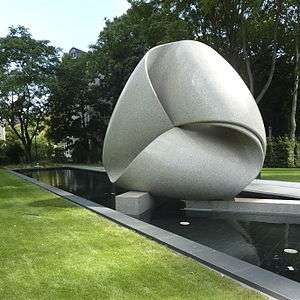Concrete art

Max Bill,
Continuity (Colossus of Frankfurt), 1986, collection:
Deutsche Bank,
Frankfurt am Main. Max Bill "was keen on creating works based on mathematical and geometric foundations—material manifestations of intellectual processes that resisted symbolism." The sculpture, of
Sardinian granite, weighs 66 tons.
[1] Concrete art is an art movement with a strong emphasis on abstraction. The artist Theo van Doesburg, closely associated with the De Stijl art movement, coined the term "concrete art" as he in 1930 founded the group Art Concret and articulated its features in a manifesto titled "The Basis of Concrete Art", signed by four other artists of the group, including Otto G. Carlsund, Jean Hélion and Leon Tutundjian. The manifesto explained that the resultant art should be non-referential insofar as its components should not refer to, or allude to, the entities normally encountered in the natural, visible world. This is a distinction from abstraction generally. In a more general sense "abstract art" could and often does include the "abstraction of forms in nature".[2] But "concrete art" was intended to emanate "directly from the mind" and consequently to be more "cerebral"[2] than abstract art generally. Concrete art is often composed of basic visual features such as planes, colors, and forms.[3] "Sentiment" tends to be absent from concrete art.[2] The "hand" of the artist may be difficult to detect in finished works of concrete art; concrete art may appear, in some instances, to have been made by a machine.[3] Concrete art often has a core visual reference to geometry whereas more general abstract art may find its basis in the components of the natural world. A formulation of a description of concrete art might include a considerable reliance on the formal qualities of an artwork. Theo Van Doesburg's manifesto stated that art "should receive nothing from nature's formal properties or from sensuality or sentimentality. We want to exclude lyricism, dramaticism, symbolism, etc…."[4] In concrete art a mathematical equation can serve as a starting point. Concrete art can include painting and sculpture.[5]
The term was popularized by the artist Josef Albers, and the artist Max Bill further promoted the ideas associated with concrete art, organizing the first international exhibition in 1944. The movement came to fruition in Northern Italy and France in the 1940s and 1950s through the work of the groups Movimento d'arte concreta (MAC) and Espace. In 1960 Max Bill organized a large exhibition of Concrete Art in Zürich illustrating 50 years of its development.[6]
International dimension
Concrete art, optical art, kinetic art and programmatic art bring together groups around the world characterized by similar concerns.[7]
| City |
Group |
Year |
Artists |
| Buenos Aires |
Asociación Arte Concreto Invención |
1945 |
|
| Buenos Aires |
Movimento Madi |
1946 |
|
| Copenhagen |
Linien II |
1947 |
Ib Geertsen, Bamse Kragh-Jacobsen, Niels Macholm, Albert Mertz, Richard Winther |
| Milan |
Movimento Arte Concreta (MAC) |
1948 |
Atanasio Soldati, Gillo Dorfles, Bruno Munari, Gianni Monnet |
| Zagreb |
Group Exat 51 |
1951 |
|
| Paris |
Group Espace |
1951 |
|
| Rio de Janeiro |
Grupo Frente |
1952 |
Aluísio Carvão, Carlos Val, Décio Vieira, Ivan Serpa, João José da Silva Costa, Lygia Clark, Lygia Pape, Vicent Ibberson |
| São Paulo |
Grupo Ruptura |
1952 |
Waldemar Cordeiro, Geraldo de Barros, Luis Sacilotto, Lothar Charroux, Kazmer Fejer, Anatol Wladslaw, Leopoldo Haar |
| Ulm |
Hochschule für Gestaltung |
1953 |
|
| Düsseldorf |
Gruppo Zero |
1957 |
Otto Piene, Heinz Mack, Günther Uecker, Yves Klein, Piero Manzoni, Lucio Fontana, Jean Tinguely, Joseph Beuys, Piero Dorazio |
| Cordoba |
Equipo 57 |
1957 |
|
| Padua |
Gruppo N |
1959 |
Alberto Biasi, Ennio Chiggio, Toni Costa, Edoardo Landi, Manfredo Massironi. |
| Milan |
Gruppo T |
1959 |
Giovanni Anceschi (1939), Davide Boriani (1936), Gabriele De Vecchi (1938), Gianni Colombo (1937-1993) e Grazia Varisco (1937) |
| Paris |
Motus/GRAV |
1960 |
Hugo Demarco, Moyano, Horacio Garcia Rossi, Julio Le Parc, Francois Morellet, Francisco Sobrino, Yvaral (Jean Pierre Vasarely) |
| Cleveland |
Anonima Group |
1960 |
|
| Rome |
Gruppo Uno |
1962 |
Gastone Biggi, Nicola Carrino, Nato Frascà, Achille Pace, Pasquale Santoro, Giuseppe Uncini. Palma Bucarelli |
| Moscow |
Group Dvizjenije |
1962 |
|
| Genoa |
Gruppo Tempo 3 |
1963 |
|
| Praha |
Synthese |
1964 |
|
Representative artists
References
- ↑ Monolith on the Water—Max Bill’s "Continuity" in a New Location; Deutsche Bank Art works
- 1 2 3 "Concrete Art". Museum of Modern Art, NYC (Excerpt from Grove Art Online). Retrieved 2014-07-14.
- 1 2 "Concrete art". MOCA/Museum of Contemporary Art, Los Angeles (Excerpt from Robert Atkins, Artspeak, Abbeville Press, 1990). Retrieved 2014-07-14.
- ↑ Washington State University/Dr. Michael Delahoyde; commentary on Concrete art
- ↑ ArtSpeak: A Guide to Contemporary Ideas, Movements, and Buzzwords, 1945 to the Present; Abbeville Press; ISBN 978-0789203656
- ↑ Walker, John. "Concrete Art / Art Concret / Arte Concreta / Konkrete Kunst". Glossary of Art, Architecture & Design since 1945, 3rd. ed.
- ↑ Alessandro Del Puppo, L'arte contemporanea: Il secondo novecento, Einaudi, 2013, table 3 page 238.
Bibliography
- Museum am Kulturspeicher (ed.): Concrete Art in Europe after 1945 - The Peter C. Ruppert Collection. Ostfildern-Ruit: Hatje Cantz, 2002. ISBN 3-7757-1191-0
- Concrete art definition reference in Danish that includes richard Winther as one of the main artists in the movement under the area of Linien II http://kunstonline.dk/diverse/ordbog/?id=155
- Dempsey, Amy. Art in the Modern Era: A Guide to Styles, Schools & Movements. NY: Harry N. Abrams Inc., Pub., 2002
External links

